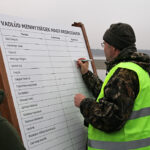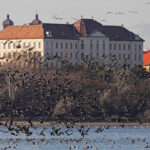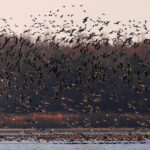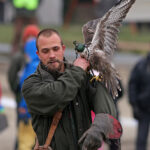The purpose of bird ringing
In order to gather information about wild birds, individually marking them in some way is a useful tool. This is usually done with a numbered ring on the leg. The ringed and later recorded bird data – geographic coordinates, times, bird status and its condition – help to solve movement patterns of certain bird species, mapping breeding, migratory and wintering areas, and tracking the numbers of our breeding birds year by year.
The marker ring
The most common marking method is the metal ring that is placed on the leg. Different ring types are used for different sized species, with the least uncomfortable used for each bird. On the marking ring there is the code of the ringing center (in Hungary the inscription „BUDAPEST”) and the serial number of the ring. Coloured plastic rings for marking are also increasingly used, which are put not only on the legs, but with certain species on the neck or on the wing. The enormous advantage of this type of marking is that it can be uniquely identified without catching a bird (even from hundreds of meters away with a telescope), so finding and reporting a bird with colored rings has a much greater chance compared to the metal ringed birds which need to be trapped.
Radio and satellite tracking
The most modern tools for the identification and tracking of birds are satellite and GPS beacons, which accurately represent the marked bird’s position. Although rather expensive to use, they provide researchers with highly detailed information (even over several years), often surprising professionals with completely new phenomena. Although such beacons have become smaller over the years, they are not yet available for smaller birds, those smaller than a dove. For these species (eg swallows) a geolocator can be attached. The disadvantage of this solution is that although it stores the collected information, the bird must be re-captured to read the data. Map results about birds with satellite tracking can be found at www.satellitetracking.eu.
Finding ringed birds
Upon re-capturing a ringed bird, the metal ring number is read, the bird’s data recorded, and the bird then released again. In the case of coloured rings or larger metal rings, the bird can also be identified by using high magnification binoculars without actually catching it. Often, a dead bird with a ring is found, in which case it is very important to record the circumstances.
Capturing birds
Capturing and ringing birds requires special knowledge. There are many catching methods for the different species and groups of birds. The most widespread of these is the curtain net, which is primarily used for catching songbirds. For many bird species, nestlings are tagged in the nest before they fly. This is basically the only way to ring the largest birds – such as storks, herons, eagles. About 4 million birds are ringed every year in Europe. In Hungary, from the beginning (1908) to the present day, almost 6 million birds have been marked in this way, most of them in the last two decades. The number of recoveries, re-captured birds, is nearly one million.
The ringers
Those wishing to become ringers need to take a special exam, organized by the Ministry of Agriculture. Most of the approximately 450 Hungarian bird ringers doing this work as volunteers in their spare time.
EURING
Of course, birds are not restricted by country borders, so ringing can only be successful with international cooperation. This cooperation is provided by EURING (The European Union for Bird Ringing), established in Paris in 1963, of which the Hungarian Bird Ringing Center, operating within the MME, is also a member.
I found a bird ring! What to do?
If you find a ringed bird, a marker ring, or if you observe a colored ringed bird, please notify the Bird Ringing Center. The most important information is the exact text and number on the ring, the name of the species, the place and date of finding, the name and contact details of the applicant. Data can also be uploaded online at www.ring.ac If possible, also send the ring or a photo of the bird. Your information will be added to the Bird Ringing Database, after which the center will send you the ringing data in a reply letter.
Visit our Bird Ringing Camps
The list of the different bird ringing camps in Hungary can be found on the MME website. In Komárom-Esztergom county, bird ringing takes place in Naszály, at the Ferencmajor Birding Station in the spring (from 1 April to 1 month) and in the autumn (from late July to November). The Ferenc Hopp Birdringing Camp (GPS coordinates: 47,69439, 018,27204) awaits visitors in August. School classes and excursion groups with prior registration are also welcome at the bird ringing station.
Amongst the tens of thousands of birds that rest on Tata’s Old Lake – gulls, herons, egrets, geese -some marked with coloured rings can often be seen. In the beginning, light metal rings with letter and number combinations were used, then with improvement of technology, a new type of ring appeared: colour rings which are possible to read even from a distance by using a telescope.
By placing such rings on larger birds, such as geese, much more information can be obtained by observations than is the case with metal rings. A bird with a coloured ring must be captured only once in its life, when the ring is attached. In the case of geese, the coloured ring is often placed on the neck.
From these observations we know exactly where geese come from, where they stop and how much time they spend in each place. Thanks to the unique identification, we can regularly spot old acquaintances in the masses of geese that rest on the Old Lake. Geese choose a mate for their whole life, so sometimes birds that were captured and marked together, are later observed together.Nowadays, satellite transmitters are also sometimes installed on geese, and with these we can get a very accurate picture of migration routes – including places where there are no people who could read the colored rings.
A tatai lúdvonulás számokban (.pdf)



